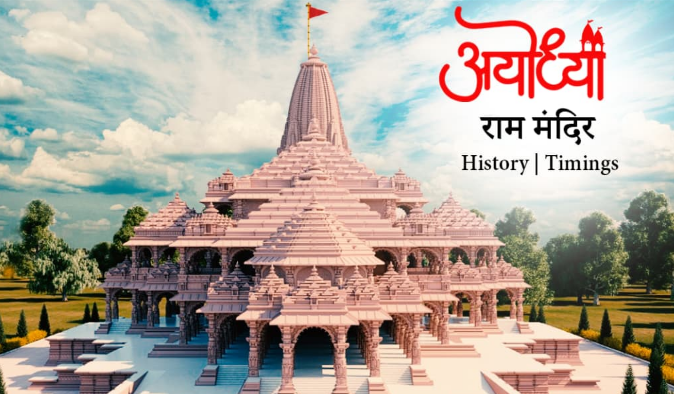The countdown for the grand ‘Pran-Pratishtha’ ceremony of Ram Mandir (Ram Temple) in Ayodhya, the birthplace of Lord Ram, has begun. The Shri Ram Janmbhoomi Teerth Kshetra or the temple trust has made elaborate arrangements to accommodate 8000 attendees including 4,000 seers from across the country and 50 guests from foreign countries. The guest list also includes a long list of celebrities and top industrialists of the country including Ratan Tata, Amitabh Bachchan, Mukesh Ambani, Gautam Adani, Kumar Mangalam Birla, Anil Agarwal, Rajnikanth, Sachin Tendulkar, MS Dhoni, Virat Kohli, Anushkha Sharma, Alia Bhatt and Ranbir Kapoor.
Pran-Pratishtha time and rituals:
The Vedic rituals began today ahead of the main ceremony on January 22.
Today, January 16, the designated host appointed by temple trust, Shri Ram Janmbhoomi Teerth Kshetra, conducted the atonement ceremony, featuring the ‘Dashvidh’ bath, Vishnu worship, and offerings to cows along the Saryu River.
On January 17, a procession will carry the idol of Lord Ram in his child-like form (Ram Lalla) to Ayodhya, with devotees bearing Saryu water in Mangal Kalash enroute to the Ram Janmabhoomi temple.
On January 18, Ganesh Ambika puja, Varun puja, Matrika puja, Brahmin Varan, and Vastu puja will take place.
On January 19, the lighting of the holy fire will take place followed by the establishment of ‘Navagraha’ and a ‘havan’.
On January 20, after washing the sanctum sanctorum of the temple with the holy water of Saryu, there will be Vaastu peace and Annadhivas rituals.
On January 21, a divine bath will take place with 125 urns, culminating in Shayadhivas, where the Ram Lalla idol would be bathed and laid to rest.
On January 22, morning puja will be held and the consecration of the Ram Lalla deity in ‘Mrigashira Nakshatra’ will take place in the afternoon followed by ‘aarti’.
Pran-Pratishtha (consecration) Of Ram Lalla is scheduled between 12:15pm and 12:45pm
• 6.30am – Shringar/Jagaran Aarti
• 12.00pm- Bhog Aarti
• 7.30pm- Sandhya Aarti
Prime Minister Narendra Modi last Friday began a special 11-day religious exercise preceding the consecration ceremony at the Ram temple.
All the guests coming to the consecration ceremony at the Ram temple on January 22 will be given ‘Ramraj’, the soil extracted during the temple’s foundation laying, as a gift’.
Ayodhya Divisional Commissioner Gaurav Dayal said arrangements have been made to seat 7,500 people in the temple premises for the ceremony. Special guests coming to Ayodhya will be given a code and their seating arrangements will be made based on this code, he said.
Architects, Style and Construction details:
1. Chief Architects – Chandrakant Sompura, and his two sons – Nikhil Sompura, Ashish Sompura.
2. Architectural Style – Indian Nagara Style
3. Length of the temple (from east to west) will be 380 feet, width 250 feet and height 161 feet.
3. The temple will be three – storied. The height of each floor will be 20 feet and a total of 392 pillars and 44 gates will be there in the temple.
4. There are 5 mandaps (pavilions) — 1st floor will have 3 pavilions and 2nd floor will have 2 pavilions — Dance Pavilion, Color Pavilion, Sabha Pavilion, Prayer Pavilion and Kriton Pavilion.
5. Statues of Gods and Goddesses are being curved on the pillars and walls
6. One person allocated one pillar for curving because the quality of the curving cannot be same if more than one person does it.
7. Entry to the temple will be from East Gate by climbing 32 stairs and from Singhdwar.
8. There will be facilities of ramp and lift in the temple for the disabled and elderly.
9. Iron and steel not used in the construction of the temple.
10. There will be a rectangular wall all around the temple. Its total length in all four directions will be 732 meters and width will be 14 feet.
The entire temple has been built with the ‘Shaligram Stone’ without the use of any Iron and steel or even cement,including pink sandstone and white marble. The stone have been brought in from ‘ Bansi Paharpur in Rajasthan’s Bharatpur’. The foundation of temple was made using Roller compacted Concrete.
Other temples at the Ram Temple premises:
1. Four temples dedicated to Sun God, Mother Bhagwati, Lord Ganapati and Lord Shiva will be built at the four corners of the park. There will be a temple of Maa Annapurna in the northern arm and a temple of Hanuman ji in the southern arm.
2. Other temples proposed in the temple complex will be dedicated to Maharishi Valmiki, Maharishi Vashishtha, Maharishi Vishwamitra, Maharishi Agastya, Nishadraj, Mata Shabari and Rishi Patni Devi Ahilya.
3. The ancient temple of Lord Shiva has been renovated on Navratna Kuber Tila in the south-western part and Jataya statue has been installed there.
4. 14-meter-thick Roller Compacted Concrete (RCC) has been laid under the temple. It has been given the form of an artificial rock.
5. To protect the temple from soil moisture, a 21-feet high plinth has been made of granite.
6. Sewer treatment plant, water treatment plant, water system for firefighting and independent power station have been constructed independently in the temple complex, so that there is minimum dependence on external resources.
7. A Pilgrim Facility Centre with a capacity of 25,000 people is being constructed, where there will be lockers to keep the luggage of the pilgrims and medical facilities.
8. There will also be facilities of bathroom, toilet, wash basin, open tubs in the temple premises.
9. The temple is being constructed completely according to Indian tradition and with indigenous technology. Special attention is being given to environment –water conservation, of the total area of 70 acres, 70% of the area will remain green forever.
10. Out of 44 doors, 42 doors are to be gold plated.
Construction cost of the temple:
1. The Shri Ram Janmabhoomi Teerth Kshetra Trust has spent- Rs 900 crore on the construction of the Ram Temple in Ayodhya between feb 5, 2020 and March 31, 2023. The temple is expected to be built at a total cost of 18,000crore.
The Shri Ram Janmabhoomi Teerth Kshetra Trust was set up for the construction and management of Ram Temple in Ayodhya by the Government of India on February 2020.
Idols selected for installation at Ram Temple –
1. A new idol of Ram Lalla sculpted by Arun Yogiraj from Mysuru has been selected for installation at the Ram Temple. The statue is a 51-inch-tall figure in black stone in the form of a five-year-old Ram Lalla and weighs around 150-200 kgs.
2. The current Ram Lalla idol, which has been worshipped for the last 70 years, will also be kept in the sanctum sanctorum of the new temple.
Materials used in construction of the Ram Temple-
1. Bansi Paharpur Pink Sandstone from Rajasthan’s Bharatpur district have been used in the main temple structure.
2. Granite Stones have been used in the plinths.
3. White Makrana and Colored Marbles have been used for the inlay work.
4. Teakwood has been used for the construction of the doors of the temple.
5. Special Bricks with “Shri Ram” inscribed on them have been used in its construction the bricks is named as Ram Shilas.
6. Shaligram Rock from Gandaki river bank in Nepal.
7. Copper Plates from Indian Copper Complex at Ghatsila, Jharkhand.
8. Gold and Ashtadhatu (an alloy of eight metals) are used.
9. The colour of the Temple is Saffron.





